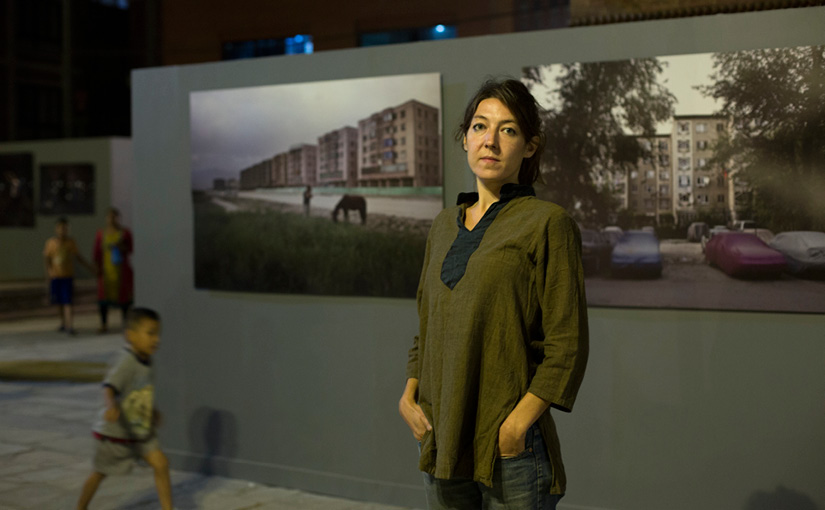How long were you in Afghanistan? How did you first approach the country?
I’ve been working in Afghanistan for almost 10 years. I was based there from 2007 to 2013. For the last few years, I’ve been coming and going between Paris and Kabul.
The first thing I remember about Afghanistan was that everything was grey and brown, the color of mud. It was my first experience in a conflict area. But I felt really comfortable. Even though everything was different from where I grew up—France—I liked it as soon as I arrived. I wanted to be a war photographer, and the first pictures I took were of a drug-using community because for me that was one of the aftermaths of the war. I’d come for just a month, and as I liked it, I said I’d stay two months. I went back to France, and then I found a way to go back to Afghanistan and finally got established there.
The photos in your exhibition, Afghan Dream, aren’t the typical war photos we’re used to seeing from Afghanistan. Why did you decide to document everyday life instead?
For the first three or four years in Afghanistan, I was working for newspapers and magazines. I remember 2010 was a very intense year, where I worked and travelled a lot, which in a way was exciting but very frustrating as well, because I didn’t have the time to stay long with people. I was running everywhere and I got sick of that.
I’d been in the country then for four years, and I told my friends how beautiful the country was and how beautiful the people were, and how it was a wonderful place to be. But I wasn’t showing why I liked the country in my pictures; I was doing the same thing as other photojournalists. What I was showing in my pictures was completely mainstream, images relating only to the conflict, to the bad image of the country. I decided to take more time to photograph the country, but as I wanted to, with my eyes and my heart. My work took a U-turn. I tried to put emotion and tenderness in my photography. I became subjective. In 2011, I started to work only in Kabul, and I didn’t want to directly cover the conflict. It was not easy to show Kabul as a quiet city, but I was not new to the country and not on a short trip, so it was easy to defend my point of view.
What was the response from Paris about these new pictures you were taking—of the Afghan middle class, of everyday life?
The most interesting response was from the Chief Editor at the magazine I worked at in Paris. When they saw my pictures of middle class Afghans they said “These are not real, pure Afghans—they are American, they are not Afghan.” I said, “They are Afghan.” The Chief Editor told me, “But they are common, they are not the Afghan we all have in mind, with the turban and the beard, and…”
And I said, “How do you know how Afghans look, you in your office in Paris? And what does it mean. What is a ‘pure’ Afghan?”
There are 5 million refugees outside the country. The conflict has been going on at this time for about three decades. There is a big diaspora. People went abroad but are coming back because it’s the end of the war. With new technology, people are more connected to the war. So what does it mean, to be a ‘pure’ Afghan? The young people in the cities are changing. But that was the reaction from Paris—“They are not Afghan.”
Was there anything striking you learned about the Afghan middle class in the course of your project?
The most interesting thing was that photographing the middle class was a political act. In Afghanistan, the middle class completely disappeared with the war. And it appeared again with the massive international presence and the money and economic growth that that brought. Showing them meant saying, “Look, this is the result of the political and military strategy in Afghanistan.”
Quite a few of the photos in your collection are indoor shots.
Yes, in Kabul, it’s quite complicated to take pictures outside, because the military is everywhere, because there are a lot of places you don’t have the right to photograph. And anyway, people are not comfortable having photos taken outside due to custom and tradition. I also know I have as much time I want to work when I am indoors—it’s not comfortable to take too much time outside. I also wanted to create an intimate portrait of the city and its inhabitants, and in Afghanistan that means taking indoor photographs.
What else did it take to get your subjects to go about their lives with you around—to make them comfortable?
First of all, you have to respect your subjects. One of my goals is to get a good picture, sure, but I think it is even more important that people have a good time. I say, just do your stuff, try to forget that I’m around. I don’t want them to remember the experience as an awful moment and regret welcoming me. I try to be respectful and put myself at the same level as them. I photographed them like I would have photographed a French citizen—a neighbor, a colleague in France. I didn’t think, “I am French and they are Afghan”—I photographed them as my friends, people living in the same city I was living in. I wanted to reduce the distance between us. Because generally a Western audience can’t imagine that Afghans are thinking the same things as them, that they have the same feelings. That’s important in my body of work: to turn the light on similarities between us.
Did Afghanistan, and your impression of the country, change during the course of the project?
It surely changed. When I started the project, in 2012, I interviewed the people, the young were really confident about the future. They told me, “We want to go abroad for studies, but we want to come back and give to the nation.” Two or three years later, their outlook was not the same. In 2014, most NATO troops withdrew. Everybody put a lot of hope on the presidential election, but it was a failure. So now, when you talk to them again, they don’t have hope. They are still living, they are doing their best. But the people who told me they wanted to stay now tell me they want to escape. Some have gone abroad to study but haven’t come back. In a few years, their mentality has changed.
These changes are also why I called the project “Afghan Dream.” It’s a reference to the American Dream, because it’s the entrance of Afghan society into consumption. But the middle class society is also a dream. When I started the project, I thought the middle class was already fragile, I didn’t know if it would last. That’s why I decided to take these pictures: I wanted to show what Afghanistan was like at a point, at one moment. It’s changing already.
(This interview has been edited and condensed)

